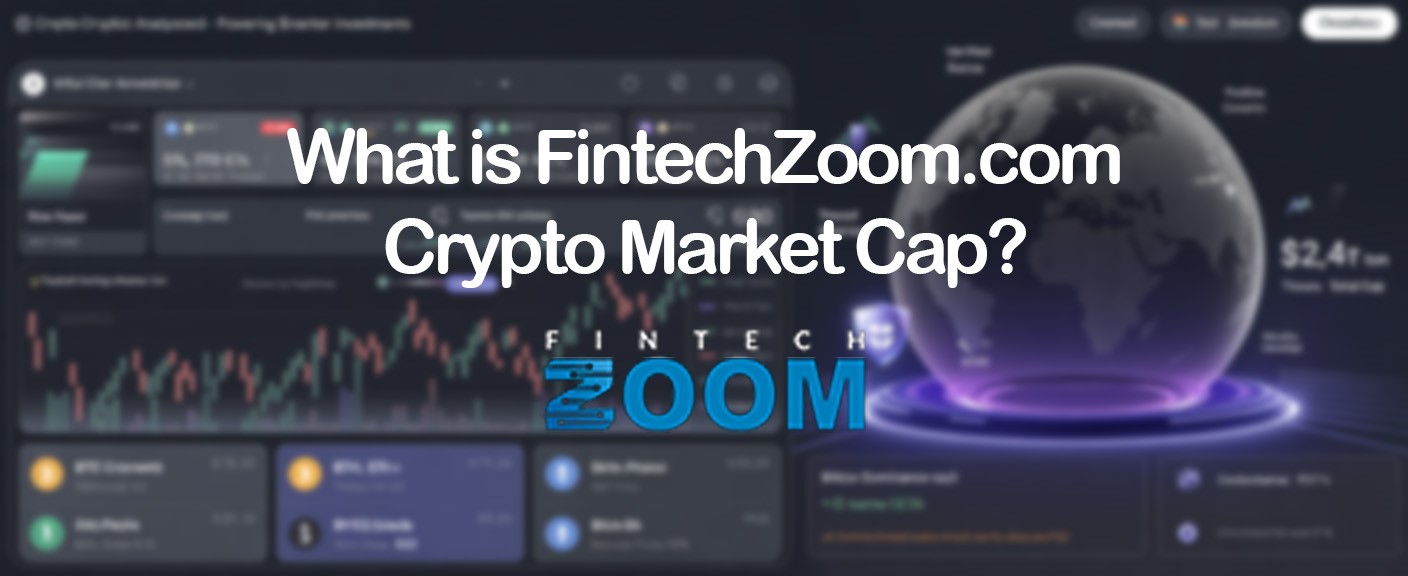
[ad_1]
Cryptocurrencies have revolutionized the financial landscape, offering new opportunities for investment, trade, and innovation. As of today, the market is rapidly evolving, and understanding its complexity can be daunting. This article delves into the landscape of cryptocurrencies with insights gleaned from FintechZoom’s detailed market cap analysis. We will explore what market capitalization means, the power dynamics within the crypto market, and trends that are shaping the future.
Understanding Cryptocurrency Market Capitalization
What is Market Capitalization?
Market capitalization, commonly referred to as market cap, is a significant metric in the cryptocurrency world. It is calculated by multiplying the current price of a cryptocurrency by its total circulating supply. This simple metric helps investors gauge the relative size of a cryptocurrency, providing insights into its market position and potential for growth.
The Formula
The formula is straightforward:
[
\text{Market Cap} = \text{Price} \times \text{Circulating Supply}
]
For example, if a cryptocurrency has a price of $100 and a circulating supply of 1,000,000 coins, its market cap would be:
[
\text{Market Cap} = 100 \times 1,000,000 = 100,000,000
]
Importance of Market Cap in the Crypto Landscape
Market cap is crucial for several reasons:
-
- Assessment of Value: Investors often use market cap to assess whether a cryptocurrency is overvalued or undervalued.
- Assessment of Value: Investors often use market cap to assess whether a cryptocurrency is overvalued or undervalued.
-
- Risk Evaluation: Generally, cryptocurrencies with larger market caps are perceived as less risky compared to smaller ones.
- Risk Evaluation: Generally, cryptocurrencies with larger market caps are perceived as less risky compared to smaller ones.
-
- Investment Decisions: A cryptocurrency’s market cap can influence investment decisions; institutional investors often prefer to engage with larger market cap cryptocurrencies due to their perceived stability.
- Investment Decisions: A cryptocurrency’s market cap can influence investment decisions; institutional investors often prefer to engage with larger market cap cryptocurrencies due to their perceived stability.
FintechZoom’s Market Cap Analysis
FintechZoom has conducted an extensive market cap analysis, providing an overview of current market trends, performance metrics, and emerging cryptocurrencies. This analysis is vital for anyone looking to navigate the crypto landscape.
Current Market Trends
The Rise of Altcoins
While Bitcoin remains the largest cryptocurrency by market cap, altcoins are gaining momentum. Altcoins, or alternative coins to Bitcoin, are diversifying the market and providing unique solutions that address various challenges.
Popular Altcoins
-
- Ethereum (ETH): Beyond just a crypto asset, Ethereum serves as a platform for decentralized applications (dApps) and smart contracts.
-
- Binance Coin (BNB): Originally launched to facilitate trading on the Binance Exchange, BNB has evolved into a multifaceted token with various utilities.
DeFi and Its Impact on the Crypto Landscape
Decentralized Finance (DeFi) is reshaping how people engage with financial products and services. By removing intermediaries, DeFi offers users control over their assets in a peer-to-peer manner.
Key Players in DeFi
-
- Uniswap: A decentralized exchange (DEX) that allows users to trade tokens directly from their wallets.
-
- Aave and Compound: Platforms that facilitate lending and borrowing of cryptocurrencies in a decentralized manner.
NFTs and Their Emergence
Non-fungible tokens (NFTs) have taken the crypto world by storm, offering unique digital ownership that appeals to artists, gamers, and collectors alike.
NFT Marketplaces
-
- OpenSea: One of the largest NFT marketplaces, enabling users to create, buy, and sell digital art and collectibles.
-
- Rarible: A community-driven marketplace that empowers users to mint, buy, and sell NFTs.
Navigating Market Volatility
Understanding Crypto Volatility
The crypto market is known for its volatility, with prices frequently experiencing sharp swings. This can be both an opportunity and a risk for investors.
Causes of Volatility
-
- Market Sentiment: News cycles and social media can rapidly influence market sentiment, causing drastic price movements.
-
- Regulatory Developments: Changes in regulatory frameworks can lead to uncertainty, affecting investors’ confidence and market stability.
Strategies for Managing Volatility
-
- Diversification: Investing across a range of cryptocurrencies can mitigate risk.
- Diversification: Investing across a range of cryptocurrencies can mitigate risk.
-
- Staking: Participating in staking allows investors to earn rewards on their holdings while potentially stabilizing the market.
- Staking: Participating in staking allows investors to earn rewards on their holdings while potentially stabilizing the market.
-
- Long-term Holding: HODLing, or holding on for dear life, is a strategy where investors retain their assets despite short-term volatility.
- Long-term Holding: HODLing, or holding on for dear life, is a strategy where investors retain their assets despite short-term volatility.
FintechZoom’s Market Cap Insights
Data-Driven Approach
FintechZoom employs a data-driven approach to market cap analysis, providing reliable, up-to-date insights that help investors make informed decisions. Their analysis highlights key trends, such as:
-
- Shifts in Market Dominance: Tracking the dominance of Bitcoin compared to altcoins reveals insights into market sentiment and investor behaviors.
- Shifts in Market Dominance: Tracking the dominance of Bitcoin compared to altcoins reveals insights into market sentiment and investor behaviors.
-
- Emerging Cryptos: Identifying emerging cryptocurrencies that could capture significant market shares is pivotal for investors looking for the next big opportunity.
- Emerging Cryptos: Identifying emerging cryptocurrencies that could capture significant market shares is pivotal for investors looking for the next big opportunity.
Trends Shaping the Future of Crypto
-
- Institutional Adoption: Big players in finance are increasingly investing in cryptocurrencies, viewing them as a viable asset class.
- Institutional Adoption: Big players in finance are increasingly investing in cryptocurrencies, viewing them as a viable asset class.
-
- Blockchain Technology Advances: Continuous improvements in blockchain technology are reducing transaction costs and improving efficiency, attracting broader adoption.
- Blockchain Technology Advances: Continuous improvements in blockchain technology are reducing transaction costs and improving efficiency, attracting broader adoption.
-
- Environmental Concerns: As discussions around sustainability intensify, cryptocurrencies are under pressure to develop greener solutions like Proof of Stake (PoS) protocols.
- Environmental Concerns: As discussions around sustainability intensify, cryptocurrencies are under pressure to develop greener solutions like Proof of Stake (PoS) protocols.
The Importance of Security
As cryptocurrencies gain traction, so does the importance of security against hacks and scams. FintechZoom’s analysis emphasizes the need for:
-
- Secure Wallets: Utilizing hardware wallets for storing assets provides an extra layer of security.
- Secure Wallets: Utilizing hardware wallets for storing assets provides an extra layer of security.
-
- Auditing Smart Contracts: Collaborating with auditing firms can help in identifying vulnerabilities in smart contracts.
- Auditing Smart Contracts: Collaborating with auditing firms can help in identifying vulnerabilities in smart contracts.
Future Outlook: What’s Next for Cryptocurrency?
The future of cryptocurrency remains uncertain yet promising. With ongoing developments in technology, regulatory environments, and market sentiment, the landscape will continue to evolve.
Potential Challenges
-
- Regulatory Scrutiny: Governments worldwide are increasingly scrutinizing cryptocurrencies, which could lead to restrictions and affect market dynamics.
- Regulatory Scrutiny: Governments worldwide are increasingly scrutinizing cryptocurrencies, which could lead to restrictions and affect market dynamics.
-
- Market Maturity: As the market matures, the exuberance of initial hype may subside, leading to slower growth rates.
- Market Maturity: As the market matures, the exuberance of initial hype may subside, leading to slower growth rates.
Opportunities for Investors
-
- Innovative Financial Products: With the rise of DeFi, new financial products are emerging, allowing for diverse investment strategies.
- Innovative Financial Products: With the rise of DeFi, new financial products are emerging, allowing for diverse investment strategies.
-
- Increasing Global Adoption: As more businesses accept cryptocurrencies, the demand for digital currencies is expected to rise.
- Increasing Global Adoption: As more businesses accept cryptocurrencies, the demand for digital currencies is expected to rise.
-
- Technological Advancements: Innovations in blockchain technology are likely to create new use cases, thus fostering growth in the sector.
- Technological Advancements: Innovations in blockchain technology are likely to create new use cases, thus fostering growth in the sector.
Frequently Asked Questions (FAQs)
What is Cryptocurrency?
Cryptocurrency is a digital or virtual currency that uses cryptography for security. It operates on decentralized networks based on blockchain technology.
How is Market Capitalization Calculated?
Market capitalization is calculated by multiplying the current price of the cryptocurrency by its circulating supply.
Why is Market Capitalization Important?
Market capitalization provides insights into the size and stability of a cryptocurrency, helping investors make informed decisions.
What are Altcoins?
Altcoins are cryptocurrencies other than Bitcoin. Examples include Ethereum, Litecoin, and Ripple.
What is DeFi?
Decentralized Finance (DeFi) refers to financial services that use smart contracts on blockchains, enabling users to lend, borrow, and trade assets without intermediaries.
What are NFTs?
Non-fungible tokens (NFTs) are unique digital assets that represent ownership of specific items, artworks, or collectibles on the blockchain.
Conclusion
Navigating the crypto landscape can be complex, but insights from FintechZoom’s market cap analysis offer a detailed understanding of current trends and future opportunities. By being informed and leveraging data-driven insights, investors can make educated decisions in this ever-evolving market.
In essence, as cryptocurrencies continue to mainstream acceptance and technological advancements unfold, the potential for innovation and growth in this dynamic sector remains substantial. Whether you are a seasoned investor or a newcomer, understanding the nuances of market capitalization and current trends is key to navigating this alluring landscape.
[ad_2]







